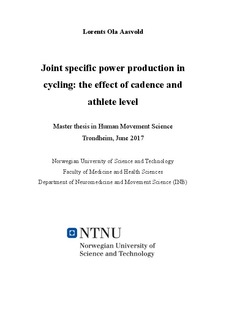Joint specific power production in cycling : the effect of cadence and athlete level
Master thesis
Permanent lenke
http://hdl.handle.net/11250/2451368Utgivelsesdato
2017Metadata
Vis full innførselSamlinger
Sammendrag
Introduction: Low cadence (<60 rpm) interval training is a commonly used training method among cyclists. The effect of cadence and work rate on the joint specific power production in cycling has previously been studied, but research has primarily focused on cadences above 60 rpm, without examining the effect of low cadence on joint contribution to power. The purpose of this study was to investigate joint specific power production in recreational and elite cyclists during low- and moderate cycling at a range of different cadences, and to determine if a low cadence at moderate intensity could provide similar hip joint power and associated muscle activity as cycling at high intensity with a freely chosen cadence.
Method: Ten recreational cyclists and nine elite cyclists performed cycling bouts at seven different pedalling rates and four intensities. Joint specific power was calculated from kinematic measurements and pedal forces using inverse dynamics. Muscle activity in gluteus maximus (GM) and vastus lateralis (VL) was measured using surface EMG.
Results: A main effect of cadence and athlete level on the relative hip- and knee joint Power was found. Increasing cadence led to increasing knee joint power and decreasing hip joint power, with the exception at low cadence (<60 rpm), where there was no effect of cadence. The elite group had higher relative hip joint power and lower relative knee joint power compared to the recreational group. The hip joint power at high intensity with a FCC did not differ to the hip joint power at moderate intensity with a low cadence (<60 rpm).
Discussion: The present study demonstrates that there is an effect of cadence on the hip- and knee joint contribution in cycling, however, the effect only occurs from 60 rpm and upward. It also demonstrates that there is a difference in joint contribution between elite- and recreational cyclists, and provide evidence for the possibility of achieving similar hip joint power at moderate intensity as at high intensity by altering the cadence.
Conclusion: The results from the present study indicates that there is a difference in pedalling technique between recreational and elite cyclists, and that the effect of cadence on relative hip- and knee joint contribution is present only from and above 60 rpm.
